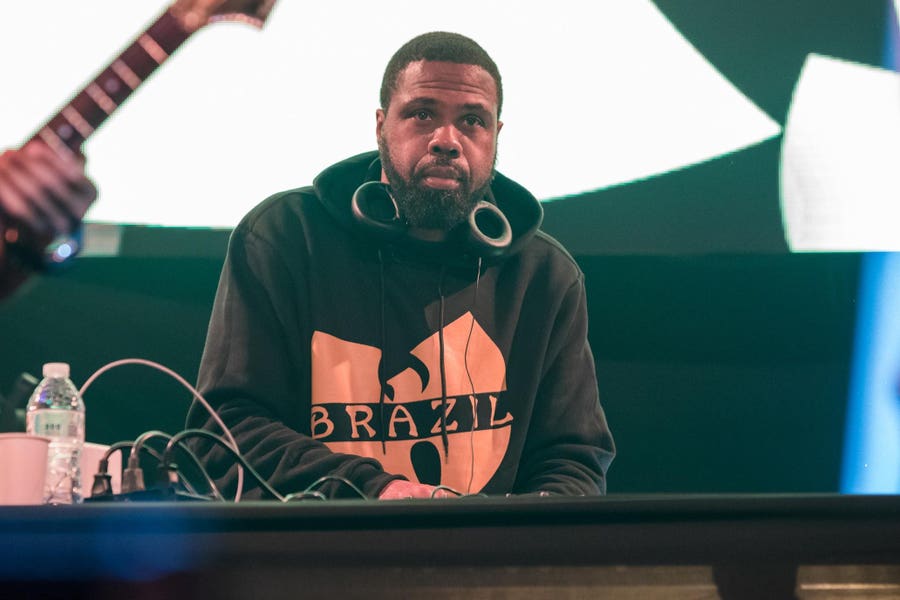
Defying expectations, DJ Mathematics gathers all nine living members of the Wu-Tang Clan for the release of Black Samson, The Bastard Swordsman, a boom-bap-infused collectible album crafted to stand the test of time rather than chase algorithmic trends.
Last month, I got the chance to build with DJ Mathematics about everything surrounding this unique release. What can be concluded is how legacy, creativity, and ownership can still move like strategy in hip-hop.
“I put a lot of blood, sweat and tears, my passion and money into doing this myself. You know? So I had to figure out a way—how will I make money off of my art?”
Although Black Samson features all nine living members of the Wu-Tang Clan and his produced by legendary group’s official DJ, it is not a Wu-Tang album, according to Mathematics. Instead, it is an independent project by DJ Mathematics, with its own distinct vision and authorship. However, given the sound, lineup, and legacy associated with the Wu-Tang Clan, fans will understandably interpret Black Samson as part of the broader Wu-Tang universe.
Unlike many who merely talk “ownership,” DJ Mathematics is an active practitioner. Rather than chasing algorithms or seeking placements on streaming platforms, he is taking an on hands approach by pressing his own vinyl with top-notch packaging and ultimately developing a self-sustaining ecosystem. By taking control of his artistic vision and distribution, DJ Mathematics is pursuing a unique path that challenges the conventional forms of the music industry.
Each ‘Black Samson’ vinyl is wrapped in its own one-of-one cover.
Courtesy of DJ Mathematics
During this year’s Record Store Day, in collaboration with 36 Chambers, Ruffnation, Virgin Music Group, and Marcoverse, Mathematics dropped Black Samson as a vinyl-only audiophile-grade double LP. It wasn’t your typical crate filling delight either. There were only 5,000 copies up for grabs with each one wrapped in its own exclusive jacket, no two covers alike. The artwork made by artist Steven Perkins, was reimagined and remixed by Marcoverse’s Mixprint technology.
“It was actually drawn by an artist,” said DJ Mathematics. “His name is Steven Perkins. He actually drew all the pieces, all the variants. They got some technology where they took all his artwork and then start mixing it all up and shuffling it. And that’s how you get all the unique and different covers.”
Black Samson is a straight-up boom-bap piece of glory exuding a grimy, cinematic, unapologetic vibe encapsulating a specific hip-hop vibe.
You have West Coast staple Kurupt, alongside Ralph McDaniels. Yes, the Ralph McDaniels, setting it off like its Video Music Box in 1994 performing that nostalgic Wu-Tang skit element on the intro track “Sucker Free City.”
NEW YORK, NEW YORK – APRIL 25: (Rear L-R) Elgin Turer ” Masta Killa”, Dennis Coles “Ghostaface … More
WireImage
The track “Mandingo” features Raekwon, Inspectah Deck, Method Man and Cappadonna building with bars like it is 1997 all over again. And then there’s “Roar of the Lion,” a multi generational cut weaving RZA, U-God and Kool G Rap, the golden era legend and pioneer of mafioso rap, a style that Raekwon would later master. Smoothness is introduced with “Claudine,” a movement featuring Method Man, Ghostface Killah and singer Nicole Bus. Black Samson goes on to complete the cipher with the presence of some new blood including Benny the Butcher, 38 Spesh and RJ Payne. Though each is a seasoned MC in their own right, these brothers have become standout voices in the real rap resurgence over the past decade.
The album also features deep cuts like “Cleopatra Jones” with Raekwon and Masta Killa, and “Executioners from Shaolin” with Inspectah Deck, GZA, and Cappadonna. There’s even a vinyl-only bonus track, “Charleston Blue, Legend Of A Fighter” featuring Crooked I, Cappadonna, and Nicole Bus, while Kameron Corvet conducts the gliding outro on ”Troubled Man.”
SAO PAULO, BRAZIL – APRIL 2: Wu-Tang Clan logo on stage at Espaco Unimed on April 2, 2023 in Sao … More
Getty Images
Mathematics is the only person outside of the Clan themselves that can gather all nine members for an album, despite the method. He is not just Wu-Tang’s official DJ, he ‘s family, an architect and the bridge. Long before the album credits, Mathematics etched his legacy in ink. He is the mastermind behind the iconic Wu-Tang “W,” a logo that he designed for RZA that started as a symbol for the clan and evolved into a global emblem of hip-hop culture.
His fingerprints are all over the Wu-Tang Clan catalogue. From producing tracks like Cappadonna’s solo debut “Oh Donna” on The Pillage, to the “Wu Banga 101” banger on Supreme Clientele, to gritty joints like “Do You Really” and “Cobra Clutch,” DJ Mathematics is without a doubt a lab-first builder of the Wu-Tang sound.
“For a lot of them, I was their brother first and foremost, even before DJ,” said Mathematics. “People put DJ in front of my name, but it was never DJ Mathematics. It was always Mathematics or Allah Mathematics.”
The Black Samson release is a business model in itself that considers art as asset, scarcity as a driver, and storytelling as the differentiator.
But make no mistake, Mathematics is not unfamiliar with the act of adapting. He’s watched the industry move from cassettes to CDs to mp3 files to straight up streaming. “You get left behind if you don’t evolve,” he said. Early on, he resisted Serato and held tight to his crates. Now, he embraces technology but solely on a strategic basis. The video for “Mandingo” is fully AI-generated. Not out of laziness, but out of necessity. Coordinating a video shoot with Wu members scattered across the globe was a challenge for Mathematics. So he certainly turned to AI, but never allowed that artificial mind to dictate his creative seed.
“For somebody else to come and grab ownership, I’m not cool with that,” he told me. “Especially when you put in your heart, your time, money, your heart into everything. For somebody to come along and put value on what you do and say, I value it at this and I’ll take it for that. It’s like, nah.”
With 2025 tour dates lined up and a live show now elevated with a band, dancers, actors, and full set curation, along with the Wu, Mathematics is building a multimedia experience rooted in a key foundational hip-hop ethic: the ability to show and prove. This goes beyond nostalgia. It’s about a hip-hop class act packaging authenticity in a way that translates into merch, licensing, collectibles and lasting reverberation.
“I grew in my music because I felt sampling—and I got nothing against sampling, sampling is dope, and I would still sample to this day if I wanted to,” said Mathematics. “But creatively, we chopped it up and we made things out of it. We did what we did. But then some beats, I felt like, okay, I just looped it and put drums on it. Is that really creativity? Did I really do that?”
“If I did that with AI, then I would feel the same way. It’s like, nah, I still gotta make my music. I gotta be creatively hands-on musically. I gotta make the sounds in my head, I have to bring [them] out. I can’t allow a machine to dictate that for me.”
This post was originally published on this site be sure to check out more of their content.







